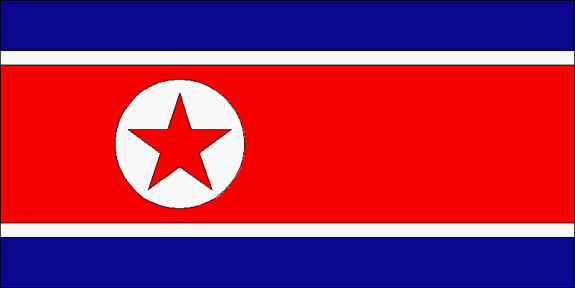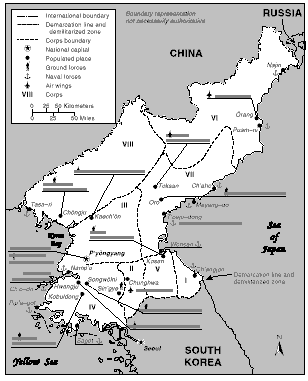





 In 1992 North Korea was divided among the conventional geographic corps. The army's
armored and mechanized corps, composed of independent combined arms brigades tailored to the
restrictive terrain of the peninsula, are positioned along the avenues of approach as exploitation and counterattack forces.
In 1992 North Korea was divided among the conventional geographic corps. The army's
armored and mechanized corps, composed of independent combined arms brigades tailored to the
restrictive terrain of the peninsula, are positioned along the avenues of approach as exploitation and counterattack forces.
As of 1996 major combat units consisted of 153 divisions and brigades, including 60 infantry divisions/brigades, 25 mechanized infantry brigades, 13 tank brigades, 25 Special Operation Force (SOF) brigades and 30 artillery brigades. North Korea deployed ten corps including sixty divisions and brigades in the forward area south of the Pyongyang-Wonsan line.
As of 1996 the North Korean ground forces were composed of twenty corps commands including four mechanized and two artillery corps as well as a Tank Instruction Guidance Bureau and an Artillery Command, and one Light Infantry Instruction Guidance Bureau which controls special operations forces. On the eastern front is deployed I Corps, V Corps on the central eastern front, II Corps on the central-western front, and IV Corps on the western front. In the central and Pyongyang areas III, VII and IX Corps, and the Pyongyang Defense Command are deployed. The VI, VIII, X and XI Corps are in the rear.
The VIII Army Corps is in charge of protecting major military facilities in the central area, including a missile base located in the vicinity of P'yongyang. The North Korean Army established the VIII Army Corps, with the corps headquarters in Yomju County, North P'yongan Province, and assigned the corps to protect major military facilities in the central area of North Korea. NDC Chairman Kim Chong-il gave on-the-spot guidance to the VIII Army Corps, which is also called the Large Combined Unit No. 593, on 2 November 1998. North Korea has disbanded the VIII Special Army Corps, which intensively trained agents for infiltration into the South and newly established the Light Infantry-Men Guidance Department of the early 1980s.
North Korea has organized a grand total of seven million men and women into reserve units. Reserve Military Training Unit, Worker-Peasant Militia, and the Young Red Guards make up most of the number. The units are managed by the Party Civil Defense Department in peacetime, but are placed under the Ministry of Defense in contingencies. War mobilization measures usually assign Reserve Military Training Unit to the front or regional defense in war, while the other two units are assigned to maintain security in the rear, guard duty for important facilities, etc. About 30% of all North Koreans between the ages fifteen to sixty are mobilized for reserve units:
North Korea's massive mechanized infantry and tank units, organized at corps and brigade levels and positioned in depth along the major routes of the attack line, are able to concentrate force on exploiting a breakthrough and enlarging the results of combat operations. The North Korean artillery units, protected in covered trenches and underground bases, can deliver deep fire support without exposure while their multiple rocket launchers are capable of concentrating fire support. North Korea's river-crossing engineering forces armed with more than 600 amphibious vehicles and over 2,300 S-type floating bridge sections can transport troops and equipment for speedy river-crossing operations.
The army has an extensive facility hardening program. Almost all the forward deployed artillery can be stored in wellprotected underground emplacements. The passive defenses in the forward corps include a large bunker complex to conceal and protect infantry forces, mechanized units, and war mat�riel stockpiles. Beginning in the late 1970s, North Korea began a major reorganization and modernization of its ground forces. North Korea began to produce a modified version of the 115mm gunned T-62 tank, which was the Soviet army's main battle tank in the 1960s. Based on general trends and photography of armed forces parades, it is clear that North Korea has made considerable modifications to the basic Soviet and Chinese designs in its own production. In the 1980s, in order to make the army more mobile and mechanized, there was a steady influx of new tanks, self propelled artillery, armored personnel carriers (APCs), and trucks. The ground forces seldom retire old models of weapons and tend to maintain a large equipment stock, keeping old models along with upgraded ones in the active force or in reserve. The army remains largely an infantry force, although a decade-long modernization program has significantly improved the mobility and firepower of its active forces.Between 1980 and 1992, North Korea reorganized, reequipped, and forward deployed the majority of its ground forces. The army places great emphasis on special operations and has one of the largest special operations forces in the world--tailored to meet the distinct requirements of Korean terrain. Between 1984 and 1992, the army added about 1,000 tanks, over 2,500 APC/infantry fighting vehicles (IFV), and about 6,000 artillery tubes or rocket launchers. In 1992 North Korea had about twice the advantage in numbers of tanks and artillery, and a 1.5-to-1 advantage in personnel over its potential adversaries, the United States-Republic of Korea defenses to the south. Over 60 percent of the army was located within 100 kilometers of the DMZ in mid 1993.
Although the majority of units remain "straight-leg" infantry forces, that is, lacking significant motorized or mechanized transport, the army contains a significant number of well equipped mechanized units, with about 2,500 APCs. These mobile forces are equipped with a mix of older Soviet-made APCs, some Chinese-made APCs, and some indigenously produced APCs, such as the M-1985.
As of 1996 the main equipment of the North Korean ground forces included over 3,800 tanks including 2,750 T-54/55/59s, 800 new model T-62 and light tanks, and about 250 outdated T-34s. It was also equipped with more than 2,800 armored vehicles consisting of BTR series and Type M1973. Its artillery forces possessed over 8,300 of the 76.2 mm, 100 mm, 122 mm, 130 mm, 152 mm, and 170 mm howitzers and guns, over 2,700 of the 107 mm, 122 mm, 132 mm, 240 mm multiple rocket launchers, and more than 12,500 anti-aircraft guns.
Probably because of its initial Soviet tutelage and the limited ground attack capability of the air force, great emphasis is placed on using massive artillery firepower. North Korean ordnance factories produce a variety of self-propelled guns, howitzers, and gun-howitzers. In the 1980s, North Korea produced a significant amount of self-propelled artillery, mating towed artillery tubes with chassis already in the inventory. North Korean strategic thought also seems to be based on the primacy of developing an offensive capability, reflecting an appreciation for firepower probably dating to the Korean War. Further, P'yongyang is willing to invest the time and effort necessary for effective defense of its ground forces from air attack and artillery fire.
With the exception of the 170mm M-1978 Koksan gun first noted in a parade in 1985, a new turreted self-propelled gun observed in a 1992 parade, and perhaps a few other systems, most artillery was developed from older Soviet and Chinese designs. All incorporate proven technologies or components. North Korea continues to produce a range of Soviet antitank guns, most of them dating from 1940s and 1950s designs, and ranging in size from 57mm through 100mm. Infantry units also are armed with Soviet bloc-derived equipment. The North Korean army was not uniformly successful in its 1980s efforts to modernize its forces in support of a high-speed offensive strategy; more needs to be done to update the army's mobility, artillery, and air defense elements. North Korea has increased its tank fleet, but incomplete information suggests that it remains based largely on dated Soviet technology with retrofitted indigenous improvements. Although the quality and quantity of mobile anti-aircraft gun systems remains unknown, there is no indication of any mobile surface-to-air missile (SAM) systems other than man-portable systems such as the SA-7 and SA-14 or SA-16 (based on parade photographs) entering the inventory to augment North Korea's static air defense umbrella. Lack of SAM systems could be a major deficiency in the army's tactical air defense capability during mobile offensive operations. However, in artillery systems the army appears to have made the most of its limited technological base. It has increased the artillery force while maintaining relative quantitative and range superiorities over its potential southern adversary and improving force mobility. By the early 1990s the chances that North Korea will further modernize its forces appear limited. The technological level of P'yongyang's industrial base appears to ensure that, with the possible exception of narrow areas of special interest, built-in obsolescence will be unavoidable, regardless of how undesirable.
| 1992 Number | 1999 Number | |
|---|---|---|
| Strength | +1,100,000 | 996,000 |
| Organization | ||
| Corps | 20 | |
| Conventional | 8 | 12 |
| Mechanized | 4 | 4 |
| Armor | 1 | ? 2 |
| Artillery | 2 | 2 |
| Geographic | 1 | |
| Military district commands | 9 | |
| Divisions / Brigades | 153 | |
| Infantry divisions | 26-30 | 60 |
| Reserve and pacification divisions | 22-26 | |
| Infantry brigades | 3-6 | |
| Reserve and pacification brigades | 18+ | |
| Mechanized and mobile brigades | 23-30 | 25 |
| Armor brigades | 14-15 | 13 |
| Artillery brigades | 20-30 | 30 |
| Special operations forces brigades | 22 | 25 |
| Special operations forces battalions | 7 | |
| Equipment | ||
| Total medium and light tanks | 3,600 | 3,800 |
| T-54/55/59 | +2,200 | |
| T-62 | +600 | |
| T-34 | n.a. | |
| APCs | 2,500 | 2,270 |
| Other light tanks (PT-76/China's T-62/63 and North Korea's M-1985) | n.a. | |
| Artillery | 11,200 | |
| Self-propelled | +5,500 | |
| Towed | +3,000 | |
| Multiple rocket launchers | 2,400 | |
| Mortars | ||
| 60-160mm | +9,000 |
n.a.--not available.
